|
|
|
Sort Order |
|
|
|
Items / Page
|
|
|
|
|
|
|
| Srl | Item |
| 1 |
ID:
099774
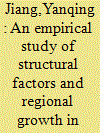

|
|
|
|
|
| Publication |
2010,
|
| Summary/Abstract |
Based on data of 31 Chinese provinces over the period 1980-2004, the study in this paper presents new evidence on the effects of structural shocks and structural transformation on growth and convergence among the Chinese regions. The division of overall regional growth in labour productivity into three components - growth due to structural shocks, growth due to structural transformation and a 'residual' indicating growth due to region-specific changes - provides us with a better framework than the traditional one-sector Solow growth model for attributing growth and convergence to various different sources. Among other findings, the study has shown that during 1990-1999, structural shocks worked to widen the gap between rich regions and poor regions in China, while structural transformation worked to narrow the gap.
|
|
|
|
|
|
|
|
|
|
|
|
|
|
|
|
| 2 |
ID:
099773
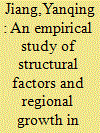

|
|
|
|
|
| Summary/Abstract |
Based on data of 31 Chinese provinces over the period 1980-2004, the study in this paper presents new evidence on the effects of structural shocks and structural transformation on growth and convergence among the Chinese regions. The division of overall regional growth in labour productivity into three components - growth due to structural shocks, growth due to structural transformation and a 'residual' indicating growth due to region-specific changes - provides us with a better framework than the traditional one-sector Solow growth model for attributing growth and convergence to various different sources. Among other findings, the study has shown that during 1990-1999, structural shocks worked to widen the gap between rich regions and poor regions in China, while structural transformation worked to narrow the gap.
|
|
|
|
|
|
|
|
|
|
|
|
|
|
|
|
| 3 |
ID:
161097
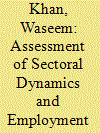

|
|
|
|
|
| Summary/Abstract |
This study has analysed structural transformation and inter-sectoral relationships
of the Indian and the Chinese economy. Variation in employment dynamics
across the sectors and growth instability is also examined by taking data from
the World Development Indicators (WDI, 2015) of the World Bank. The study
has revealed that there is a gradual decline in agriculture in both the countries.
Both the economies are now concentrating at service sectors. China is fully
exploiting its industrial sector potential while India has been lagging behind in
this sector. Johansen’s cointegration approach revealed the existence of one
cointegration relationship among all the three sectors, namely, agricultural,
industrial and services, at 5 per cent level of significance for both the countries.
A passive employment shift has been seen from agriculture to non-agriculture
sector in India. Occupational transformation in China is faster than India. Policy
makers should focus on job generation, especially in services and labour intensive
manufacturing sector in India. China should try to create jobs in industrial and
services sector because agriculture sector has been sharply declining and is still
carrying huge load of employment.
|
|
|
|
|
|
|
|
|
|
|
|
|
|
|
|
| 4 |
ID:
174780
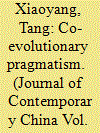

|
|
|
|
|
| Summary/Abstract |
There is a gap between the elusive concept of Beijing Consensus and China’s effective practices to promote economic growth at home and in other countries. This article aims to expound this phenomenon by examining both the rationale underlying China’s structural transformation and the corresponding practices in development cooperation. Using a case study on the evolution of infrastructure construction within China and abroad, this article argues that China's success has little to do with a new pattern of state capitalism, but rather presents a different manner of understanding and facilitating modernization. Target-oriented non-linear synergism can drive comprehensive transformation more effectively in developing countries than model-oriented linear mechanism. With a consistent goal, the pragmatic thinking enables multiple stakeholders to coevolve in diverse contexts through open attitude.
|
|
|
|
|
|
|
|
|
|
|
|
|
|
|
|
| 5 |
ID:
160821
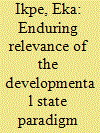

|
|
|
|
|
| Summary/Abstract |
Emerging economies have recently faced commodity price declines that reinforce the instability of natural resources as a basis for socio-economic transformation. This has re-energised arguments for industrialisation as necessary for such transitions. Drawing upon classical development economics theory, this paper offers a deployment of an enhanced developmental state paradigm (DSP) that highlights the roles of agriculture and mineral resources in the pursuit of industrial progress. This application of the DSP has its basis in narratives on Asian developmental states, with a focus on mineral resource endowment. Employed with reference to Africa’s key emerging economy and net petroleum exporter, Nigeria, the DSP shows how the state, influenced by significant milieus, has enabled linkages between oil and agriculture that can drive industrial transformation. The paper finds that linkages between oil and agriculture are well established; however, economic, social and political influences on the state have engendered agriculture’s limited onward contribution to structural change.
|
|
|
|
|
|
|
|
|
|
|
|
|
|
|
|
| 6 |
ID:
101165
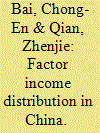

|
|
|
|
|
| Publication |
2010.
|
| Summary/Abstract |
This paper investigates changes in aggregate labor share in China during 1978 and 2007 with a particular focus on the 1995-2007 period during which official statistics report a drop of 12.45 percentage points in labor's share of national income (labor share). Our main findings are: (1) The reported fall in aggregate labor share is overstated. According to the official statistics released by the NBS (2007a), the labor share fell 5.25 percentage points from 2003 to 2004. However this dramatic decline, 42.16% of the total reported decline of the labor share from 1995 to 2007, is completely due to the changes in the way NBS break down the operating surplus state-owned and collective-owned farms and the mixed income of the owners of individual economy; (2) For the last three decades, two main forces have been driving shifts in the aggregate labor share: (i) structural transformation between the agriculture and non-agriculture sectors and (ii) shifts in the labor share within the industry sector; (3) From 1995 to 2003, these two effects are both negative and together drive down aggregate labor share by 5.48 percentage points. The structural change explains 61.31% of the decline and the remaining 38.69% of the decline is due to the changes in the labor share within sectors, primarily in the industry sector; (4) Labor share in agriculture is lower than labor share in services. Therefore, when the service sector grows relative to the agriculture sector in the economy, the aggregate labor share of income declines; and (5) Restructuring of the SOEs and expanded monopoly power are the main reasons for the decline of labor share within industry after 1998. Relative price shifts, the factor input ratio, and biased technological progress are all insignificant forces for this decline because the substitution between factors in the industry sector is nearly unit elastic.
|
|
|
|
|
|
|
|
|
|
|
|
|
|
|
|
| 7 |
ID:
147387


|
|
|
|
|
| Summary/Abstract |
The gendered nature of the agricultural sector is significantly influenced by the political and socio-economic and cultural structure of any society. The division of labor between males and females within the family farm is seriously affected as a response to economic pressures along with the impact of other restrictions imposed by predetermined gender roles. In the Palestinian context, economic pressures were created mainly by the structural transformation in Palestinian agriculture following the Zionist settler colonization of Palestine, along with other minor factors related to the Palestinian neoliberal economic policies dictated by the international financial institution and Zionist interests. This article argues that the gendered nature of the Palestinian agriculture sector has been transformed and has promoted women's exploitation as follows: First, restructure of the agricultural employment by the decline of both women's and men's employment of the total Palestinian labor force within serious exploitive and fluctuating conditions; second, changes in tasks and division of labor, women's property rights for agricultural land resources and services provided by the Palestinian Authority; and finally increasing women's burden by increasing their time allocation for agricultural tasks. The data presented in the article are based on a comprehensive analysis of secondary information on Palestinian agriculture, and primary data collected in 2010 with the help of a few households case studies (life history) from two locations in the central region of the West Bank.
|
|
|
|
|
|
|
|
|
|
|
|
|
|
|
|
| 8 |
ID:
153415
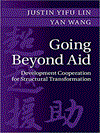

|
|
|
|
|
| Publication |
Cambridge, Cambridge University Press, 2017.
|
| Description |
xvi, 216p.pbk
|
| Standard Number |
9781316607152
|
|
|
|
|
|
|
|
|
|
|
|
Copies: C:1/I:0,R:0,Q:0
Circulation
| Accession# | Call# | Current Location | Status | Policy | Location |
| 059130 | 338.91/LIN 059130 | Main | On Shelf | General | |
|
|
|
|
| 9 |
ID:
140637


|
|
|
|
|
| Summary/Abstract |
On July 17, 2015, People’s Daily announced that a new deputy director of the Chinese Communist Party’s Central Propaganda Department (the official translation has been changed to Department of Publicity in recent years) had appeared at a conference on children’s literature in Beijing. This was the first official notice that Tuo Zhen, the former director of propaganda in Guangdong province, had been promoted to a powerful position in the central government. Tuo had become famous in 2013 thanks to his personal intervention to cut and rewrite key passages of the newspaper Southern Weekend’s New Year’s editorial, hours before it went to press.
|
|
|
|
|
|
|
|
|
|
|
|
|
|
|
|
| 10 |
ID:
182750


|
|
|
|
|
| Summary/Abstract |
Structural transformation is a key feature of economic development. Traditional literature attributes it to changes in the sectoral composition of consumption. Different from it, we argue that “servicification” of investment goods, induced by investment-composition technological change, becomes an increasingly important reason for structural transformation, particularly for the rise of the services economy. Our study of the input output tables finds that the share of service inputs in investment goods has grown significantly in many countries since the 1980s, especially for investment-intensive economies such as China. To assess if the investment channel is quantitatively significant, we build a standard model with three broad sectors, but instead add an investment production function employing factors from all three sectors. Moreover, we incorporate investment-composition technological change by allowing the productivities of the three sectoral inputs to evolve over time. We calibrate the model to the Chinese economy from 1981 to 2014 and perform counter-factual experiments accordingly. We find that investment-composition technological change accounts for 33.1% decline in employment share of agriculture, 36.0% increase in employment share of manufacturing and 31.5% increase in employment share of services over the period. The magnitude of this effect on the share of services keeps growing, particularly after 2000. Our findings are not unique for China, but also apply to other economies experiencing the “servicification” of investment.
|
|
|
|
|
|
|
|
|
|
|
|
|
|
|
|
| 11 |
ID:
173746


|
|
|
|
|
| Summary/Abstract |
This review paper provides a new narrative by combing through the experiences of structural transformation among developing countries and discussing the roles of government and market in different contexts. Country performance has been influenced by the prevailing development thinking: the structuralism in the 1950s–1970s, which stresses an active government's role to overcome market failures for industrialization, and the neoliberalism in the 1980s–present, which advocates for eliminating government failures to build up a well‐functioning market. We find that almost all countries failing by following structuralism in their industrialization and neoliberalism in their transition to a market economy, and the few countries successful in catching up have a few characteristics that go against the prevailing structuralism and neoliberalism. The new structural economics, generated from the experiences of successful East Asian economies and proposing active facilitating roles of government in a market economy to remove market failures, will gain traction and take root.
|
|
|
|
|
|
|
|
|
|
|
|
|
|
|
|
| 12 |
ID:
178431


|
|
|
|
|
| Summary/Abstract |
We model the evolution and determinants of shares of agriculture, manufacturing and services to gross domestic product for four South Asian countries (Bangladesh, India, Sri Lanka and Pakistan) for 41 years (1974–2018) to understand their structural transformation pattern. Determinants of shares were classified into three broad categories: ‘country fundamentals’, ‘policy’ and ‘decadal dummies’. This is the first article to investigate the empirical regularities of the structural transformation pattern and their determinants for this region. The generalized least squares estimation technique for panel data was applied. We find mixed evidence in support of structural transformation. With the increase in per capita income, the share of agriculture decreases and that of services increases, partially supporting the Kuznets hypothesis; however, the share of manufacturing sector shows a more tepid rise and even decreases in some model specifications. Thus, the Kuznets model of structural transformation is supported to some extent, but not strongly for these countries.
|
|
|
|
|
|
|
|
|
|
|
|
|
|
|
|
| 13 |
ID:
159396
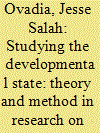

|
|
|
|
|
| Summary/Abstract |
This paper examines theoretical and methodological issues in the study of African developmental states. We argue that applying this concept beyond East Asia must take into account changes in the global economic context – in particular systemic tendencies towards deficient consumer demand – to uncover the conditions under which demand for commodity production remains or becomes expansionary. We further argue for a mixed methods case study approach to structural transformation, blending quantitative and qualitative evidence at multiple levels of analysis. The examples of concrete manufacturing and oil and gas in Nigeria and Tanzania illustrate our approach to researching state-led development in Africa.
|
|
|
|
|
|
|
|
|
|
|
|
|
|
|
|
|
|
|
|
|